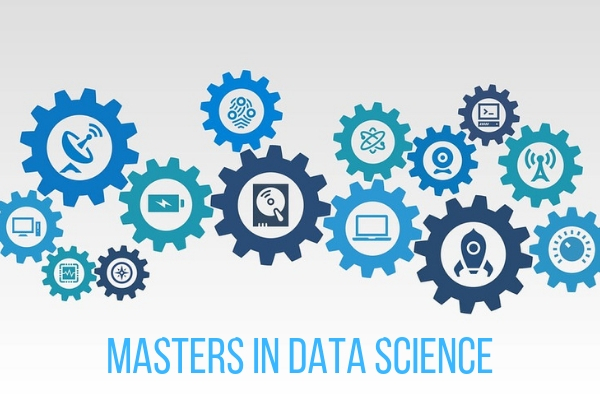What Can I do with a Masters in Data Analytics Online

A frequently asked question: Is a masters in data science worth it? Yes, a Master’s in Data Science can be worth it if you aim for a career in the field that offers high earning potential, job opportunities, and the chance to work on cutting-edge projects. It equips you with skills in data analysis, machine learning, and data engineering, which are in demand across various industries. However, it’s a significant investment in terms of time and money, so it’s essential to evaluate your career goals and consider alternatives like specialized certificates or bootcamps based on your needs and objectives.
In today’s data-driven world, the significance of data analytics spans across industries, driving decision-making, innovation, and competitive advantage. This blog introduces a roadmap for individuals armed with a Master’s in Data Analytics, exploring the myriad opportunities that await in this dynamic field.
Roadmap: Navigating Your Career with a Masters in Data Analytics:
This roadmap aims to guide aspiring professionals through the multifaceted landscape of data analytics, empowering them to make informed decisions, build a successful career, and contribute meaningfully to the data-driven revolution.
Understanding the current state of the data analytics field involves recognizing its dynamic nature, key industry players, and the transformative impact it has on decision-making processes. This knowledge forms a solid foundation for individuals navigating a career with a Master’s in Data Analytics.
1. The Growing Importance of Data Analytics:
- Highlight the increasing reliance on data analytics in diverse sectors, from business and finance to healthcare and technology.
- Emphasize the transformative impact of analytics on optimizing processes, enhancing efficiency, and gaining actionable insights.
2. Potential Career Opportunities:
- Introduce the vast array of career possibilities that open up with a Master’s in Data Analytics.
- Explore roles such as Data Scientist, Business Analyst, Machine Learning Engineer, and more, showcasing the versatility of skills acquired.
This roadmap aims to guide aspiring professionals through the multifaceted landscape of data analytics, empowering them to make informed decisions, build a successful career, and contribute meaningfully to the data-driven revolution.

(1) Understanding the Landscape:
Understanding the current state of the data analytics field involves recognizing its dynamic nature, key industry players, and the transformative impact it has on decision-making processes. This knowledge forms a solid foundation for individuals navigating a career with a Master’s in Data Analytics.
1. Overview of the Current State of the Data Analytics Field:
- Delve into the current landscape of the data analytics field, emphasizing its rapid growth and evolution.
- Discuss key trends, emerging technologies, and the role of data analytics in shaping the future of industries.
2. Identification of Key Industries Leveraging Data Analytics:
- Highlight industries at the forefront of leveraging masters in data analytics for strategic insights and competitive advantage.
- Examples include:
- Finance: analyzing market trends, risk assessment, and customer behavior.
- Healthcare: Enhancing patient care, optimizing operations, and predictive analytics
- Technology: Informing product development, improving user experience, and data-driven innovation
3. Exploration of the Impact of Data Analytics on Decision-Making Processes:
- Examine how data analytics are transforming decision-making processes across sectors.
- Discuss the shift from intuition-based decisions to data-driven insights, leading to more informed and strategic choices.
- Showcase real-world examples of organizations harnessing data analytics for effective decision-making.
(2) Mastering Essential Skills:
Mastering a diverse set of skills, both technical and soft, is integral to excelling in a data analytics career. The emphasis on practical projects ensures that individuals not only understand theoretical concepts but can also apply them to real-world challenges, making them valuable assets in the data analytics landscape.
1. Core Skills Acquired in a Master’s in Data Analytics Program:
- Explore the fundamental skills imparted through a Master’s in Data Analytics, ranging from foundational to advanced concepts.
- Cover areas such as statistical analysis, database management, and the interpretation of complex datasets.
2. Emphasis on Technical Skills:
- Coding: Highlight the importance of programming languages such as Python, R, and SQL in data analytics. Discuss how proficiency in coding facilitates data manipulation, analysis, and the implementation of algorithms.
- Machine Learning: Showcase the significance of machine learning techniques in predictive analytics, pattern recognition, and decision-making.
- Data Visualization: Emphasize the art of translating complex data into visually compelling insights, using tools like Matplotlib, Seaborn, and Tableau.
3. Emphasis on Soft Skills:
- Communication: Stress the need for effective communication skills to convey complex findings to non-technical stakeholders. Discuss the role of clear and compelling data storytelling.
- Problem-Solving: Highlight the analytical and problem-solving mindset required to address real-world challenges. Discuss how data analytics professionals approach problem-solving systematically.
4. Showcase of Practical Projects and Real-World Applications:
- Demonstrate the application of acquired skills through practical projects, showcasing their relevance to industry scenarios.
- Examples might include predicting customer behavior, optimizing supply chain operations, or developing a recommendation system.
- Discuss the impact of these projects on improving processes, driving innovation, and making data-driven decisions in various domains.
(3) Career Paths:
Navigating the masters in data analytics landscape opens doors to a variety of rewarding career paths. Understanding the intricacies of each role, along with the industry-specific requirements, allows individuals to tailor their skills and aspirations, making informed decisions as they embark on their professional journey.
1. Diverse Career Paths:
- Data Scientist: Explore the role of a data scientist, focusing on leveraging statistical methods and machine learning algorithms to extract insights and predictions from data.
- Business Analyst: Discuss the responsibilities of business analysts in interpreting data, identifying business needs, and making recommendations for improvements.
- Machine Learning Engineer: Highlight the specialization in designing and implementing machine learning models, emphasizing a strong foundation in algorithms and predictive modeling.
2. Industry-Specific Roles and Requirements:
- Finance: Examine roles such as Financial Analyst, Quantitative Analyst, or Risk Analyst, emphasizing the need for advanced statistical modeling, risk assessment, and market trend analysis.
- Healthcare: Explore roles like Healthcare Data Analyst, focusing on optimizing patient care, predicting disease outbreaks, and improving operational efficiency.
- Technology: Discuss positions like Data Engineer or AI Specialist, emphasizing expertise in data infrastructure, algorithm development, and contributing to technological innovation.
3. Skill Requirements for Each Role:
- masters in data analytics provide insights into the specific technical and soft skills required for success in each career path.
- Discuss the importance of continuous learning and staying updated on industry trends.
- Illustrate how the skill set acquired during a Master’s in Data Analytics program aligns with the demands of these diverse roles.
(4) Networking and Building a Personal Brand:
Building a robust professional network and personal brand is essential for success in the data analytics field. It not only opens doors to career opportunities but also positions individuals as valuable contributors to the community. By actively engaging on platforms like LinkedIn and participating in relevant online communities and conferences, professionals can establish a strong presence, enhance their reputation, and stay connected with the pulse of the data analytics industry.
1. Importance of Networking within the Data Analytics Community:
- Emphasize the significance of networking for career growth, knowledge exchange, and staying updated on industry trends.
- Discuss how networking fosters connections with professionals, potential mentors, and employers within the data analytics field.
- Highlight the value of collaborative opportunities and insights gained through networking.
2. Strategies for Building a Strong Professional Presence on Platforms like LinkedIn:
- Guide individuals on optimizing their LinkedIn profiles to showcase their expertise, accomplishments, and aspirations.
- Encourage regular sharing of relevant content, such as projects, articles, or insights, to establish thought leadership.
- Discuss the impact of endorsements, recommendations, and active participation in relevant groups.
3. Leveraging Online Communities, Forums, and Conferences:
- Explore the benefits of participating in online communities and forums dedicated to data analytics.
- Recommend platforms like Kaggle, Stack Overflow, or specialized forums where professionals discuss industry challenges and share solutions.
- Encourage attendance and active participation in data analytics conferences, webinars, and workshops for networking opportunities and exposure to the latest trends.
(5) Internships and Real-World Experience:
Gaining practical experience through internships after masters in data analytics is a crucial step for individuals pursuing a career in data analytics. The tips provided aim to guide individuals in securing valuable internships and making the most of these opportunities. Real-world examples serve as inspiration, showcasing the tangible benefits of internships in propelling individuals from academia to successful careers in the dynamic field of data analytics.
1. Significance of Gaining Practical Experience Through Internships:
- Highlight the importance of hands-on experience in applying theoretical knowledge to real-world scenarios.
- Discuss how internships offer a bridge between academia and industry, providing a platform for skill development and networking.
- Emphasize the impact of practical experience on enhancing employability and making individuals more marketable to employers.
2. Tips for Securing Internships and Making the Most of the Experience:
- Provide guidance on crafting a compelling resume and cover letter tailored for data analytics internships.
- Suggest strategies for identifying and applying to relevant internships, including leveraging university career services, networking, and online job boards.
- Share tips on making the most of the internship experience, such as actively seeking responsibilities, building relationships with mentors, and being proactive in learning.
3. Real-World Examples of Successful Transitions from Academia to Industry:
- Showcase the real-world success stories of individuals who transitioned from academic studies to impactful careers in data analytics.
- Explore how internships played a pivotal role in these success stories, offering practical skills, industry exposure, and networking opportunities.
- Illustrate the diverse career paths and achievements of professionals who started their journey with internships.
(6) Continuous Learning:

Continuous learning is not just a recommendation but a necessity in the ever-changing landscape of data analytics. Staying updated on industry trends, tools, and technologies ensures that professionals can adapt to new challenges, capitalize on emerging opportunities, and maintain a competitive edge in their careers. Certifications and specialized courses serve as structured pathways for acquiring new skills and validating expertise, contributing to ongoing professional development in the dynamic realm of data analytics.
1. Emphasis on the Dynamic Nature of the Field and the Need for Continuous Learning:
- Highlight the rapid evolution of the masters in data analytics field, driven by technological advancements, emerging methodologies, and evolving business needs.
- Stress the necessity for professionals to adopt a mindset of continuous learning to stay relevant and competitive in the dynamic landscape.
2. Recommendations for Staying Updated on Industry Trends, Tools, and Technologies:
- Encourage active engagement with industry publications, blogs, and reputable websites to stay informed about the latest trends and developments.
- Suggest following thought leaders, participating in webinars, and joining relevant online communities for insights into emerging tools, technologies, and best practices.
- Emphasize the importance of attending conferences, workshops, and meetups to gain firsthand exposure to cutting-edge advancements in data analytics.
3. The Role of Certifications and Specialized Courses:
- Discuss the value of certifications in validating skills and enhancing credibility within the industry.
- Provide insights into well-recognized certifications in data analytics, such as Certified Analytics Professional (CAP) or Microsoft Certified: Azure Data Scientist Associate.
- Recommend specialized courses, whether online or in-person, to deepen expertise in specific tools or methodologies, keeping in mind the evolving demands of the field.
(8) Building a Portfolio:
A well-crafted portfolio is a powerful tool for showcasing skills, experience, and problem-solving abilities to potential employers. It goes beyond listing technical achievements and communicates a narrative of how these skills were applied to address real-world challenges. During job interviews, the portfolio becomes a conversation starter, providing a structured way to discuss projects, methodologies, and the impact of data analytics work. By effectively presenting the portfolio, individuals can leave a lasting impression and demonstrate their value to prospective employers in the competitive field of data analytics.
1. Crafting a Compelling Portfolio Showcasing Projects and Achievements:
- Emphasize the importance of a well-organized portfolio that reflects a variety of projects and achievements.
- Include diverse examples that demonstrate proficiency in data analysis, machine learning, and data visualization.
- Provide clear documentation, explanations, and visuals to make the portfolio accessible and engaging.
2. Highlighting the Impact of Projects on Solving Real-World Problems:
- Discuss the significance of showcasing projects that address practical, real-world challenges.
- Clearly articulate the problem statements, methodologies used, and the impact achieved through data-driven solutions.
- Illustrate how each project contributes to solving problems within specific industries or domains.
3. Tips for Presenting the Portfolio During Job Interviews:
- Prioritize clarity and conciseness in presenting each project, focusing on key insights, methodologies, and outcomes.
- Be prepared to discuss the technical aspects of the projects while also conveying the broader business context.
- Highlight the skills and tools used in each project, demonstrating versatility and adaptability.
- Connect each project to your personal and professional growth, showcasing a learning journey through practical applications.
(9) Job Search Strategies:

Effectively navigating the job search in data analytics involves a strategic approach, utilizing targeted platforms, and tailoring application materials. By understanding the specific nuances of the data analytics field, individuals can position themselves as ideal candidates and increase their chances of landing impactful roles in this dynamic industry.
1. Effective Job Search Strategies Tailored to the Data Analytics Field:
- Utilize targeted keywords related to data analytics in job search engines to streamline results.
- Leverage specialized job boards dedicated to data science and analytics roles.
- Actively engage with professional networking platforms to discover job opportunities shared by industry peers and recruiters.
2. Utilizing Job Boards, Company Websites, and Professional Networks:
- Job Boards: Explore popular job boards like Indeed, Glassdoor, and LinkedIn Jobs, using filters to narrow down to data analytics roles.
- Company Websites: Directly visit the career pages of companies known for their emphasis on data analytics, as they often post positions on their official websites.
- Professional Networks: Leverage LinkedIn for job hunting, connecting with professionals in the field, and joining relevant groups or communities that share job opportunities.
3. Guidance on Tailoring Resumes and Cover Letters for Specific Roles:
- Resumes: Tailor your resume to highlight key skills, experiences, and achievements relevant to the specific data analytics role. Use quantifiable metrics to showcase the impact of your work.
- Cover Letters: Craft personalized cover letters for each application, expressing your genuine interest in the company and role. Align your skills with the specific requirements of the job description.
- Showcasing Projects: Reference relevant projects from your portfolio that demonstrate your ability to tackle challenges similar to those posed by the prospective employer.
(10) Interview Preparation:
Interview preparation for masters in data analytics roles requires a balanced focus on both technical expertise and soft skills. Regular practice of common interview questions and exposure to case studies and technical assessments will not only enhance your problem-solving abilities but also improve your ability to communicate your thought process effectively during interviews.
1. Key Technical and Behavioral Interview Considerations:
- Technical Considerations: Be prepared for questions related to data manipulation, statistical analysis, machine learning algorithms, and coding. Demonstrate proficiency in relevant tools and languages.
- Behavioral Considerations: Highlight soft skills such as communication, problem-solving, and adaptability. Share examples from your experience that showcase how you’ve applied these skills in a professional context.
2. Practicing Common Data Analytics Interview Questions:
- Familiarize yourself with common interview questions in data analytics, covering topics such as data cleaning, exploratory data analysis, model evaluation, and interpretation of results.
- Practice articulating your thought process and explaining the rationale behind your analytical decisions.
3. Preparing for Case Studies and Technical Assessments:
- Case Studies: Understand the structure of case studies, often used to evaluate problem-solving skills. Practice breaking down complex problems into manageable steps and communicating your approach.
- Technical Assessments: Be ready for hands-on technical assessments that may involve coding exercises, data analysis tasks, or machine learning model building. Practice similar exercises to build confidence and speed.
(11) Landing Your Dream Job:
Successfully landing your dream job after masters in data analytics involves not only securing a favorable job offer but also ensuring that the position aligns with your values and long-term goals. By negotiating strategically, considering cultural fit, and celebrating the transition, individuals can embark on a fulfilling career in data analytics with confidence and enthusiasm.
1. Strategies for Negotiating Job Offers and Evaluating Opportunities:
- Research Compensation Trends: Understand salary expectations for data analytics roles in your location and industry. Use this information to negotiate a competitive salary and benefits package.
- Evaluate Growth Opportunities: Assess the potential for professional growth, skill development, and advancement within the organization. Consider the company’s commitment to ongoing learning and development.
2. The Importance of Cultural Fit and Alignment with Career Goals:
- Cultural Fit: Consider the company’s values, work environment, and team dynamics. Assess whether your personal values align with the company culture, fostering a positive and productive work experience.
- Alignment with Career Goals: Evaluate how the job aligns with your long-term career goals. Consider whether the role provides opportunities for skill development, career advancement, and alignment with your professional aspirations.
3. Celebrating the Transition from Academia to a Fulfilling Career in Data Analytics:
- Reflect on Achievements: Acknowledge and celebrate the achievements that led to securing a data analytics position. Reflect on the skills gained, projects completed, and the journey from academia to the professional sphere.
- Share Success: Communicate your success with mentors, peers, and industry connections. Celebrate the transition as a significant milestone in your career.
Schools Offering Data Analytics Masters Programs Online in the USA:
Through online courses, professionals can learn data analysis and possibly even obtain a qualification in the field. The provider’s goals, the industry’s emphasis, and other variables will determine the differences across data analysis classes.
While any field can be pursued as a master’s degree with a bachelor’s, most students who do so have majored in computer science, statistics, or mathematics during their undergraduate studies. The most crucial things are that you understand the fundamentals of multivariate calculus, the most widely used programming languages (namely Python and Java), and at least one kind of advanced mathematics.
Masters in Data Analytics in USA: Top 10 Universities:
- Boston University—Boston, Massachusetts
- Brandeis University, Waltham, Massachusetts
- Clarkson University, Potsdam, New York
- Columbia University—New York, New York
- Colorado State University, Greenwood Village, Colorado
- Concordia University, St. Paul – St. Paul, Minnesota
- Dakota State University, Madison, South Dakota
- University of Findlay, Findlay, Ohio
- George Mason University, Fairfax, Virginia
- Georgia Institute of Technology, Atlanta, Georgia
Masters in Data Analytics in Canada: Top 5 Universities:
- University of Toronto Masters of Science in Allied Computing- Data Science
- University of British Columbia Masters in Data Science
- HEC Montreal MS Data Science and Business Analytics
- University of Waterloo MS Data Science and Artificial Intelligence
- University of Calgary MS Data Science and Analytics
Recap: (Navigating Your Career with a Masters in Data Analytics)
In conclusion, the journey from academia to a successful career in data analytics is a dynamic and rewarding adventure. Let’s recap the roadmap that paves the way for professionals equipped with a Master’s in Data Analytics:
1. Understanding the Landscape:
- Grasping the current state of the data analytics field and its impact on decision-making processes
2. Mastering Essential Skills:
- Acquiring a robust skill set, both technical and soft, essential for excelling in data analytics.
3. Career Paths:
- Exploring diverse career paths such as Data Scientist, Business Analyst, and Machine Learning Engineer.
4. Networking and Building a Personal Brand:
- Recognizing the importance of networking and strategies for building a strong professional presence.
5. Internships and Real-World Experience:
- Gaining practical experience through internships and making the most of these valuable opportunities.
6. Continuous Learning:
- Embracing the dynamic nature of the field and staying updated on industry trends through continuous learning.
7. Building a Portfolio:
- Crafting a compelling portfolio that showcases projects and achievements, emphasizing their real-world impact.
8. Job Search Strategies:
- Effectively utilizing job boards, company websites, and professional networks in the data analytics job search.
9. Interview Preparation:
- Preparing for key technical and behavioral interview considerations, practicing common questions, and being ready for case studies and technical assessments.
10. Landing Your Dream Job:
- Implementing strategies for negotiating job offers, evaluating opportunities, and ensuring alignment with cultural fit and career goals
As you embark on this exciting journey, remember that success in data analytics goes beyond technical expertise. It’s about continuous learning, effective networking, and seizing opportunities for growth. The field of data analytics is ever-evolving, and by staying curious, connected, and enthusiastic, you position yourself for a fulfilling and impactful career. Embrace the challenges, celebrate your achievements, and welcome the endless possibilities that a Master’s in Data Analytics brings to your professional journey.
Masters in Data Analytics vs Master’s in Data Science:
Both Data Analytics and Data Science are related fields but have distinct focuses and goals. Choosing between a Master’s in Data Analytics and a Master’s in Data Science depends on your career aspirations and interests. Here’s a comparison to help you decide:
In summary, a Master’s in Data Analytics primarily focuses on analyzing existing data to provide insights and make data-driven business decisions, while a Master’s in Data Science encompasses a broader range of skills, including data analytics, with a stronger emphasis on data modeling, machine learning, and predictive analysis. Data Analytics often leads to roles like Data Analyst, whereas Data Science leads to positions like Data Scientist, with differences in the tools, technologies, and industries they typically apply to. The choice between the two depends on your career goals, interests, and the level of specialization you seek.
Data analytics vs Data analysis:
Data analytics and data analysis are related terms often used interchangeably, but they have distinct meanings. Masters in data analysis refers to the process of examining, cleaning, and interpreting data to gain insights and make informed decisions. It’s a fundamental part of data analytics, which is a broader field encompassing the entire data lifecycle, including collection, storage, and the application of advanced techniques like machine learning and predictive modeling. Data analytics involves a more comprehensive approach, whereas data analysis is a specific step within that process.
See Also:
- Unveiling the Distinctions: Web Crawler vs Web Scrapers
- How to Make Money with Web Scraping Using Python
- How to Type Cast in Python with the Best 5 Examples
- Best Variable Arguments in Python
- 5 Best AI Prompt Engineering Certifications Free
- 5 Beginner Tips for Solving Python Coding Challenges
- Exploring Python Web Development Example Code
- “Python Coding Challenges: Exercises for Success”
- ChatGPT Prompt Engineering for Developers:
- How to Make AI-Generated Video|AI video generator
- 12 Best Python Web Scraping Tools and Libraries with Pros & Cons
- 7 Best Python Web Scraping Library To Master Data Extraction
- Explore the World of Character AI Generator
- Boolean Operators in Python Examples (And|Or|Not)
- Python List Slicing: 3 Best Advanced Techniques





